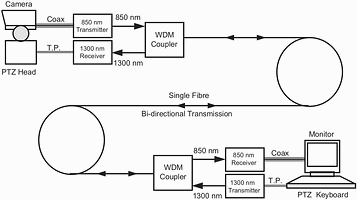
The first article in this series (Hi-Tech Security Solutions, March/April 2004) reviewed the benefits of using fibre-optics and also discussed the transmission principles involved. This article looks at what is involved in designing and implementing a practical fibre-optic system for CCTV and related applications.
The process of designing a fibre-optic system typically involves two activities:
* The selection of suitable active transmission components, based on required function(s), type and number of available or proposed fibres, and maximum link distance.
* The design of the passive fibre-optic cabling infrastructure, including types and specifications of trunk cables, joint boxes, and fibre patch panels. (This will be discussed in the final article of this series.)
Transmission components
Firstly, what transmission components are actually required to meet the system specification?
* Fixed camera systems - these are actually exceedingly simple, usually consisting of a miniature fibre-optics video transmitter and either a modular or a rack-mounted receiver. The transmitter will often be small enough to be mounted within the camera housing and will be fitted with a BNC video connector, an 'ST' optical connector and a low voltage power supply connection (typically 12 volts AC or DC). Many surveillance systems consist of a number of such cameras feeding to a central control room and in these cases the receivers will often be rack mounted in a single 19" 3U card frame, complete with an integral mains power supply.
* PTZ camera systems - PTZ camera systems are more complex, as here a second path has to be provided for the camera control signals. Generally speaking, there are two types of PTZ telemetry systems - those that require single direction telemetry transmission (from control room to camera) and those that require bi-directional transmission. Systems using bi-directional transmission are becoming increasingly popular as they permit the camera to acknowledge receipt of each command signal, hence providing more precise and reliable control. Within each of these groups there are a whole range of interface specifications, including TTL, RS232, RS422 and RS485. Other systems do not use a digital interface, but transmit data as a series of audio tones via an analog channel, similar to DTMF telephone signalling. Still others do not require a separate telemetry channel at all, but transmit data signals back up the video coax, either during the video field blanking periods or on a high frequency modulated carrier.
All these systems can be transmitted over fibre using appropriate fibre-optic transmission equipment. Fortunately it is not necessary for the client to understand the complexities of PTZ telemetry systems to define his requirements; he merely needs to identify his preferred camera control system, together with an estimate of the maximum link length, so that the appropriate equipment/fibre/operating wavelength can be recommended.
There is, however, one decision that the client normally has to make, which is to decide whether the PTZ telemetry data is to be transmitted on the same fibre as the video, or on a second fibre.
Under normal circumstances, sending simultaneous optical transmissions in opposite directions through the same section of optical fibre is unsatisfactory, because crosstalk occurs as a result of backscatter reflections within the fibre. The effect of this in a CCTV system would be to create interference on vision every time a camera control was operated.
To achieve crosstalk-free bi-directional transmission on a single fibre requires the two opposing transmitters to be operated at different wavelengths, for example at 850 nm and 1300 nm respectively (see graphic). Each end of the link is terminated with a WDM (wavelength division multiplexer) coupler, which ensures that each receiver only receives light of the correct wavelength (eg, 850 nm) from the far end transmitter; unwanted reflections from the near end transmitter will be at the 'wrong' wavelength (eg, 1300 nm) and hence rejected.

Bi-directional transmission on one fibre incurs additional expense compared with a two-fibre solution (principally the cost of the two WDM couplers). However, this may be offset by the cost saving in the reduced number of fibres required.
* Additional facilities - while the provision of fixed or PTZ video transmission meets the majority of CCTV surveillance needs, there are a number of systems that require additional services, such as audio signals, either for public address, customer 'help' points, or intercom facilities at remotely controlled access locations. Alternatively, fire and intruder alarm contact closure signals might be required as part of an integrated security network. These can all be transmitted via fibre, either using the same fibre(s) as the video network, or separately.
* Video multiplexing - it is also possible to multiplex up to 64 video and 128 audio or data signals on to one single mode fibre, with smaller numbers possible on multimode fibres. In this context, multiplexing refers to the simultaneous transmission of full screen realtime video signals, not the slow scan or split screen displays which are more commonly described by this term.
The ability to multiplex many signals or services together over a few optical fibres is extremely valuable; especially for long haul transportation CCTV networks such as motorway or railway surveillance schemes, where minimising fibre count is often vital. In other shorter range applications involving widely dispersed cameras, the benefits may be less clear, and here the use of a separate fibre per video channel should be always be considered first. The choice of whether or not to multiplex is complex and should only be made after an evaluation of all the issues involved, including system topology, overall costs and not least resilience to network damage.
For more information contact Elvey Security Technologies, 011 401 6700, [email protected], www.elvey.co.za
| Tel: | +27 11 401 6700 |
| Email: | [email protected] |
| www: | www.elvey.co.za |
| Articles: | More information and articles about Elvey Security Technologies |

© Technews Publishing (Pty) Ltd. | All Rights Reserved.